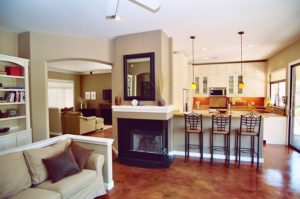
When it comes to remodeling your kitchen, it’s not just food preparation and serving you need to think about. In modern kitchen renovations, very often the kitchen is the gathering place of the home. So, when thinking of remodeling, why not combine the kitchen with a family room?
Our great-grandmothers might have worked in a kitchen that was an isolated workspace, closed off from the rest of the house. Before the invention of extractor fans, the kitchen was a smelly place and who wanted the mess and smell of fried onions spilling over into the living areas of the home?
Nowadays, the cook isn’t isolated and vent fans take care of cooking odors, but wouldn’t it be nice to have a place where the family could interact with the chef without having only to perch on stools ringing the kitchen island?
More and more, kitchens are incorporating dining rooms and sitting rooms into a unified open floor plan. Consequently, kitchen cabinets are looking more like fine furniture, and counters and islands are becoming dining tables.
When this idea of a unified space first took hold in the 1980’s, architects sometimes went a little overboard on the combined space idea. Tall ceilings led to the clatter of pots and pans reverberating through the space (drowning out the big game!) Also the mess of dirty dishes and frying pans took up every available space and seemed to spill over into the living area of the giant room.
These days a sense of psychological space between the living and kitchen area is a priority and remodeling companies are quick to take that into consideration. A raised counter can act as a screen. Not only does it create a bar where casual meals and snacks can be served, but it shields the dirty dishes from view of the family room area. Mostly this is part of a peninsula rather than an island though, when using a peninsula, a good renovation designer will make sure there is an easy exit for guests at a party congregating in the kitchen. Built-in sliding screens can also be installed to hide the kitchen mess from party guests or a remodeled kitchen can be designed so the food prep and cleaning area of the kitchen can be situated in an alcove.
Upper cabinets can help enforce a slight sense of separation without obstructing the view. The height of the bottom cabinet should be measured by taking the eye height of the tallest person in the house. That becomes the height of the upper cabinet base, so no one needs to duck to speak to people in the family room portion.
The use of a similar color palette between the two areas helps the eye connect the spaces, as does one type of flooring continued throughout. Mini-areas can be delineated with only the addition of area rugs. Crown moldings can also help the two areas connect.
Furniture in the family room may be grouped so that the cook can enter the conversation, so then he or she won’t feel so isolated.
An informal seating area between the kitchen and family room also can be added during the renovation, separating the two areas, but keeping it all one room. Also banquette seating can offer comfortable seating for people who congregate in the kitchen for more than food. Such an informal seating area is good for kids, too, who can do their homework under Mom or Dad’s watchful eye while dinner is being prepared.
When it comes to remodeling your kitchen or renovating anywhere else in your house, please think of Cornerstone Builders of Southwest Florida. Our designers will be happy to come give you a free estimate on any of your remodeling projects

